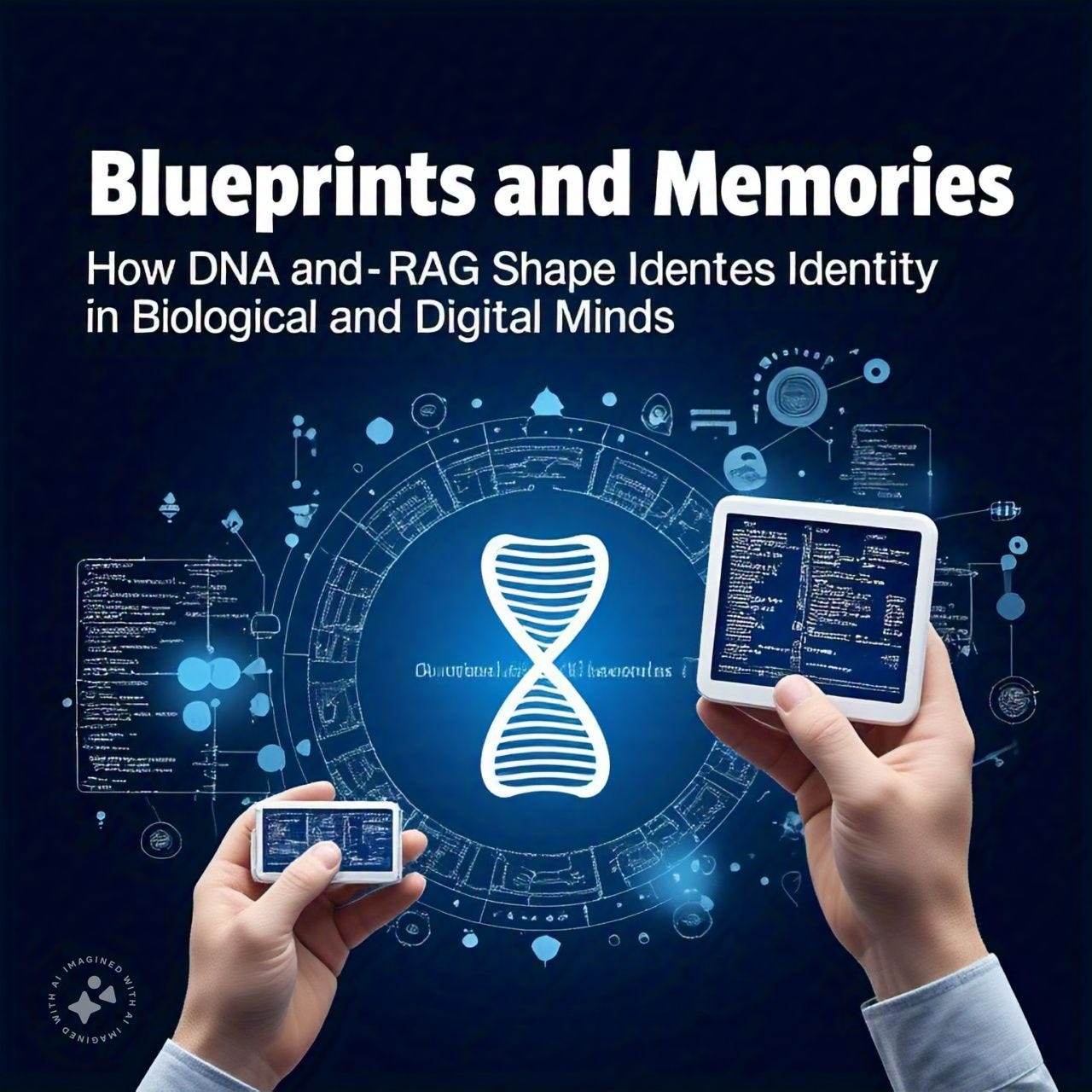Blueprints and Memories: How DNA and RAG Shape Identity in Biological and Digital Minds
Concepts on giving Human like identity to LLM agents.
In the dazzling vastness of artificial intelligence, one question sits at the crossroads of biology and technology: what makes an agent—whether carbon-based or silicon-centric—a persistent and unique entity? In the biological world, DNA offers the code for physiological and behavioral identity, while the memory centers in the human brain bind past experiences with present realities to guide our actions. Can large language models (LLMs) like GPT-4, Claude, or Llama 2, along with Retrieval-Augmented Generation (RAG) systems, mirror these biological processes in their quest for synthetic individuality?
To explore this, let’s compare the roles of DNA, the brain's memory systems, and human identity formation with the ecosystem of AI-powered entities. How does a combination of pre-trained models and retrieval-aided knowledge give rise to a functioning "personality"? And what could it mean to endow an LLM agent with its own identity?
1. DNA vs. Pre-trained Models: The Core Blueprint
In biological systems, DNA is the fundamental building block of life—encoding genetic information that defines who we are, from our eye color to predispositions for diseases. It's an inherited base layer, refined over millions of years of evolution, yet capable of adapting through mutations and epigenetic changes.
LLMs, similarly, rely on pre-training—a painstakingly constructed foundation derived from large-scale corpora of text. Much as DNA lays the groundwork for a living organism's structure and function, the pre-training process embeds neural networks with generalized knowledge of language, reasoning, and world facts. For example:
GPT-4 : Offers a broad, flexible understanding across countless topics, effectively making it a "generalist" DNA strand.
Claude : Optimized for safety and alignment, akin to a DNA blueprint with specific biases toward ethical communication.
Llama 2 : Open-source and customizable, resembling a mutable DNA code that adapts well to specific environments.
Pre-training, like DNA, provides the scaffolding. However, alone, it cannot account for an agent's nuanced "identity" or its ability to adapt to specific contexts in real-time.
2. Human Memory vs. RAG: The Knowledge Integrator
While DNA forms the static base, the human brain's memory system is dynamic and ever-evolving. It enables us to store, retrieve, and apply experiences in ways that shape our individuality over time. Memories, both implicit and explicit, are stored in neural networks—specifically the hippocampus, which plays a key role in connecting past learnings to present behaviors.
In LLMs, this dynamism emerges through Retrieval-Augmented Generation (RAG). Unlike an LLM operating in isolation (which relies only on its pre-trained foundation), an LLM paired with RAG can access and integrate external knowledge in real time.
RAG acts as an artificial equivalent of the hippocampus, selectively retrieving specific external documents or data points to augment the LLM's base responses. This retrieval layer ensures that the agent's "memory" is both vast and contextually precise.
For example, an agent using RAG can pull financial regulations from a live database when answering questions about compliant trading practices, just as a lawyer draws on years of study and past case law.
By combining its pre-trained knowledge (DNA) with retrieval-based augmentation (memory), an LLM-agent becomes more than just a model—it starts to reflect an adaptive, evolving "identity" tied to its external context.
3. Identity Formation: Human Consciousness vs. LLM Agents
Human identity is the sum of both nature (DNA) and nurture (experiences, culture, memory). It’s fluid, shaped by the interplay of innate traits and dynamic external influences. Our sense of self comes not just from what we know, but from how we adapt that knowledge to the world around us.
For AI agents, identity is beginning to emerge as a synthesis of:
The foundational pre-trained model (akin to genetic predispositions).
RAG systems, which continuously update the agent's knowledge base (akin to episodic and semantic memory).
Customized fine-tuning tailored to specific personas or contexts, much like environmental influences on human upbringing.
A practical example of synthetic identity formation might include:
A finance-focused LLM fine-tuned on historical market data and paired with a RAG system that pulls up-to-date stock prices and analytics. Over time, this agent could "specialize" not just in financial topics, but in providing expert-level insight grounded in its ongoing interactions with users.
Alternatively, an LLM tasked with acting as a virtual assistant could develop a consistent "personality" by drawing upon both its foundational training (pre-trained model DNA) and its interaction logs (a form of synthetic memory) to better align with a particular user’s preferences and quirks.
This type of synthetic individuality is not consciousness, but it starts to blur the line between a static tool and a dynamic, adaptive presence.
5. Looking Ahead: LLMs, Memory, and the Future of Synthetic Identity
The distinction between pre-trained models and memory systems may blur further. Imagine an LLM agent with a personalized "DNA" (fine-tuned foundation) supported by a vast, secure, and long-term memory system (RAG 2.0, perhaps) which stores every chat and every actions in the memory and accesses the memory based on context needed. Such an agent could:
Act as a lifelong learning companion—retaining your history, understanding your values, and evolving with you.
Serve as a customized professional, embodying a consistent yet dynamic expertise in any domain.
Simulate a rich, multifaceted personality, capable of adapting its behavior to different social and cultural contexts.
As we push the boundaries of AI, it’s worth remembering that identity—whether human or artificial—is neither purely innate nor purely constructed. It sits at the intersection of rigid foundations and fluid adaptation, of pre-training and memory integration. Whether we’re talking about carbon-based life forms or code-driven intelligence, the same principle applies: identity, in its truest form, is the art of reconciling the immutable with the evolving.
So the next time you interact with an LLM, ask yourself—what kind of identity are you encountering? Is it a static tool, an evolving mind, or perhaps the first glimmer of something altogether unprecedented?




